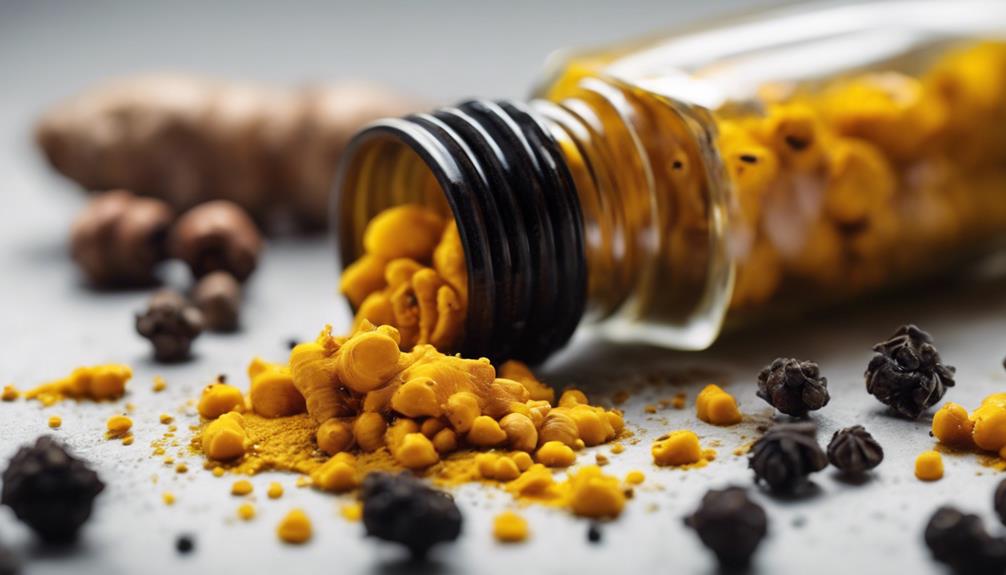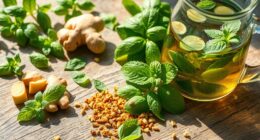In our pursuit of potent natural pain relief, we uncover a plethora of powerful painkillers derived from nature's abundant resources. Curcumin, found in turmeric, helps block inflammatory cytokines and enhance the body's pain-relieving mechanisms, offering relief for conditions like arthritis and migraines. Resveratrol, a natural anti-inflammatory, reduces inflammation and shows promise in alleviating pain, acting similarly to NSAIDs but without their side effects. Vitamin E effectively reduces pain and inflammation, promoting skin health and providing antioxidant protection. Kitchen staples like turmeric, ginger, cloves, cinnamon, and garlic offer natural pain management options. Further exploration reveals the incredible world of herbal remedies and essential oils for holistic pain relief.
Key Takeaways
- Lavender and Clove oil provide targeted pain relief.
- Curcumin in turmeric is a powerful anti-inflammatory compound.
- Resveratrol acts as nature's anti-inflammatory painkiller.
- Vitamin E offers pain relief and antioxidant protection.
- Ginger contains gingerol with potent anti-inflammatory benefits.
Understanding Natural Pain Relief
Understanding natural pain relief involves exploring the effectiveness of herbal remedies as alternatives to traditional medications. Essential oils, derived from plants and known for their therapeutic properties, are key players in this domain. These oils, such as Lavender Essential Oil and Clove oil, offer targeted relief when applied topically to specific areas of discomfort.
Lavender Essential Oil, in particular, is praised for its calming and analgesic effects, making it a popular choice for soothing headaches and muscle tension. On the other hand, Clove oil possesses potent anti-inflammatory and analgesic properties, making it a valuable asset in managing dental pain and arthritis symptoms.
When considering natural pain relief options, the inclusion of essential oils like Lavender and Clove oil provides a holistic approach to addressing various types of discomfort. By harnessing the power of these plant-derived remedies, individuals can potentially find relief from pain while minimizing reliance on traditional medications.
Power of Curcumin for Pain

Curcumin, a key anti-inflammatory compound found in turmeric, offers powerful relief for pain and inflammation. Studies have demonstrated that curcumin can be as effective as certain anti-inflammatory medications in managing pain.
By blocking inflammatory cytokines, curcumin provides significant relief for conditions such as arthritis, fibromyalgia, and migraines. Its antioxidant properties play an important role in combating oxidative stress, contributing to its pain-relieving effects.
Additionally, curcumin has the ability to enhance the body's natural pain-relieving mechanisms, making it a strong natural painkiller option. This compound's multifaceted approach to pain management makes it a promising solution for individuals seeking alternatives to traditional medications.
With its anti-inflammatory and antioxidant properties, curcumin stands out as a valuable natural remedy for alleviating various types of pain and inflammation.
Resveratrol: Nature's Painkiller

Resveratrol, a natural compound found in red grapes and berries, offers potent pain-relief properties by reducing inflammation and inhibiting the production of inflammatory markers.
It acts on the same pathway as NSAIDs, providing a safe alternative for managing chronic pain without the side effects of traditional painkillers.
Studies have shown the effectiveness of resveratrol in alleviating pain associated with inflammation, highlighting its role as a natural analgesic.
Resveratrol's Pain-Relief Properties
Among the natural painkillers available, resveratrol stands out for its significant pain-relief properties derived from red grapes and berries. This compound exhibits potent anti-inflammatory effects, making it a promising option for alleviating pain.
Research indicates that resveratrol can modulate pain transmission pathways in the body, offering a mechanism for its analgesic effects. Additionally, its antioxidant properties play a vital role in combating oxidative stress, which is often implicated in chronic pain conditions.
Studies suggest that resveratrol's ability to inhibit inflammatory cytokines may enhance its pain-relieving capabilities, particularly when combined with other anti-inflammatory agents. The evidence points to resveratrol as a natural painkiller that not only targets pain symptoms but also addresses underlying inflammatory processes.
Resveratrol's Anti-Inflammatory Effects
Research has highlighted the vital anti-inflammatory effects of resveratrol, emphasizing its role as a natural painkiller derived from red grapes and berries.
Resveratrol, commonly found in red grapes and wine, exhibits remarkable properties in inhibiting inflammatory enzymes and reducing cytokine production, which are essential mechanisms for alleviating pain.
These anti-inflammatory effects play a significant role in managing conditions such as arthritis, migraines, and fibromyalgia, where inflammation is a key contributor to discomfort and decreased quality of life.
Studies have demonstrated that resveratrol can effectively decrease pain intensity and improve the overall well-being of individuals suffering from chronic pain conditions.
Resveratrol as Natural Analgesic
With its potent anti-inflammatory properties and ability to reduce pain sensitivity, resveratrol emerges as a natural analgesic worth exploring for its pain-relieving potential. Resveratrol, commonly found in red grapes and berries, is known for its ability to inhibit pain perception by targeting inflammatory pathways in the body. Acting as a natural analgesic, resveratrol interacts with pain receptors, thereby reducing pain sensitivity. This compound's antioxidant properties aid in combating oxidative stress, a significant factor in chronic pain conditions. Research suggests that resveratrol could present a promising alternative for managing pain due to its anti-inflammatory effects and potential to alleviate pain intensity.
| Resveratrol Facts | |
|---|---|
| Found in | Red grapes and berries |
| Pain-relieving action | Inhibits pain perception by targeting inflammatory pathways |
| Mechanism | Reduces pain sensitivity through interaction with pain receptors |
| Antioxidant properties | Helps combat oxidative stress, common in chronic pain conditions |
| Potential benefits | Promising alternative for pain management due to anti-inflammatory effects |
Vitamin E: A Potent Analgesic

Vitamin E serves as a vital analgesic that effectively reduces pain and inflammation within the body. This essential nutrient, available in various forms such as tocopherols and tocotrienols, offers specific benefits for pain management.
Apart from its essential properties, vitamin E provides antioxidant protection, promotes skin health, and aids in alleviating pain symptoms. Oakwell, a reputable site, includes vitamin E as a key ingredient in its products due to its proven pain-relieving properties.
However, it's important to consult a healthcare provider before incorporating vitamin E supplements or products containing it into your pain management regimen. This ensures that the usage is appropriate and safe for individual health needs.
Top Herbs for Pain Management

Let's explore some potent herbs known for their effectiveness in managing pain naturally.
Devils Claw is recognized for easing muscular tension and pain in the back, shoulders, and neck, thanks to its analgesic properties.
Capsaicin, derived from hot peppers, can inhibit pain perception and trigger the release of endorphins, making it a powerful natural pain reliever.
Mulungu acts as an anti-nociceptive agent, providing relief from pain, anxiety, mental disorders, liver disorders, and high blood pressure.
Willow Bark, containing salicin, offers anti-inflammatory and pain-relieving effects, serving as a natural alternative to aspirin for chronic headaches and back pain.
Kratom binds to mu-opioid receptors, controlling pain perception, and acting as an alternative to opioid medications for pain management.
These herbs showcase diverse mechanisms in addressing pain and inflammation, offering natural options for individuals seeking relief without relying solely on pharmaceutical solutions.
Exploring Cannabinoids for Pain Relief

Delving into the world of cannabinoids for pain relief reveals a promising avenue in natural pain management strategies. Harnessing the potential of compounds like CBD and THC to regulate pain perception through interactions with the body's endocannabinoid system. CBD, known for its non-psychoactive nature and anti-inflammatory properties, is effective in managing chronic pain conditions.
On the other hand, THC, the psychoactive component in cannabis, also offers pain relief but may induce euphoria and other side effects. Research indicates that cannabinoids can alleviate neuropathic pain, arthritis pain, and pain associated with multiple sclerosis.
For localized pain relief without psychoactive effects, topical CBD products like creams and oils can be directly applied to the skin. The interaction between cannabinoids and the endocannabinoid system presents a novel approach to pain management, offering potential benefits for individuals seeking natural alternatives to traditional medications.
Anti-Inflammatory Benefits of Ginger

Ginger's anti-inflammatory properties are well-documented, making it a popular choice for natural pain relief and inflammation management. Here are some key points highlighting the benefits of ginger in combating inflammation:
- Bioactive Compounds: Ginger contains bioactive compounds like gingerol, known for their potent anti-inflammatory effects in the body.
- Reduced Inflammation Markers: Scientific studies have demonstrated that ginger can effectively reduce markers of inflammation, showcasing its efficacy in managing inflammatory conditions.
- Traditional Medicinal Use: For centuries, ginger has been utilized in traditional medicine to alleviate various types of pain and inflammation, underlining its historical significance in natural healing practices.
- Muscle and Joint Pain Relief: Regular consumption of ginger, whether through supplements or ginger tea, has been linked to decreased muscle soreness and joint pain, offering a natural and safe alternative for individuals seeking relief from inflammatory discomfort.
Natural Painkillers in Your Kitchen

In our kitchens, we've a treasure trove of natural painkillers at our disposal. Turmeric's curcumin, ginger's gingerol, cloves' eugenol, cinnamon's cinnamaldehyde, and garlic's allicin offer potent remedies for various aches and pains.
These common household ingredients can be utilized to create DIY pain solutions that are both effective and readily available.
Kitchen Pain Relief
Exploring the pain relief options readily available in your kitchen, you can utilize natural ingredients like turmeric, ginger, cloves, cinnamon, and garlic for their beneficial properties.
Here are some ways these kitchen staples can help with pain relief:
- Turmeric: The active compound curcumin in turmeric boasts potent anti-inflammatory properties, aiding in alleviating various types of pain.
- Ginger: Known for its anti-inflammatory effects, ginger can help ease muscle pain, migraines, and osteoarthritis discomfort.
- Cloves: With natural analgesic properties, cloves can be beneficial for relieving toothaches and headaches when used appropriately.
- Cinnamon: This popular spice not only enhances flavors but also offers potential relief from inflammation-related conditions like arthritis and muscle soreness.
Common Household Remedies
One of the convenient ways to find natural pain relief is by turning to common household remedies found in your kitchen. When dealing with chronic pain, incorporating ingredients like turmeric, ginger, cloves, peppermint, and garlic into your diet can offer relief without the need for over-the-counter medications.
Turmeric, known for its active compound curcumin, possesses powerful anti-inflammatory properties that can help alleviate symptoms of chronic pain. Similarly, ginger, often used in cooking, has been shown to reduce muscle pain and soreness due to its anti-inflammatory effects.
Cloves, another common spice, contain eugenol, which acts as a natural painkiller and anti-inflammatory agent, making it a valuable addition to combat chronic pain. Peppermint, commonly found in households, can provide relief from tension headaches and migraines by relaxing muscles.
Additionally, garlic, a staple in many kitchens, contains allicin, which can aid in reducing inflammation and pain associated with conditions like arthritis. Incorporating these natural painkillers into your daily meals may offer a natural and effective way to manage chronic pain.
DIY Pain Solutions
Let's explore our kitchen cabinets to discover natural painkillers that can provide effective DIY solutions for managing various types of pain. Here are four items commonly found in kitchens that can offer pain relief:
- Turmeric: This common kitchen spice contains curcumin, a potent anti-inflammatory compound known for its ability to alleviate pain. Adding turmeric to dishes or making a soothing turmeric tea can help reduce inflammation and provide relief from various types of pain.
- Ginger: Often found in kitchen cabinets, ginger contains gingerol, which has been shown to reduce pain and inflammation, particularly beneficial for conditions like osteoarthritis. Incorporating ginger into meals or brewing ginger tea can aid in pain relief.
- Clove: A popular spice, clove contains eugenol, a natural anesthetic that acts as a pain reliever, especially effective for toothaches. Utilizing clove oil topically or gargling with clove-infused water can help alleviate dental pain.
- Garlic: A staple in many dishes, garlic contains allicin, which possesses anti-inflammatory properties that can assist in reducing pain. Including garlic in cooking or consuming raw garlic can provide relief from various types of pain.
Frequently Asked Questions
What Is the Most Potent Natural Pain Reliever?
When looking for the most potent natural pain reliever, we find Kratom to be a standout choice. Its active compounds bind to opioid receptors, providing powerful pain relief akin to traditional opioids but with fewer side effects.
What Is the Strongest Household Painkiller?
We believe the strongest household painkiller is kratom. It effectively binds to mu-opioid receptors for potent pain relief. Kratom is a popular natural alternative to opioids, providing strong pain relief without the associated risks.
What Plant Is Used for Severe Pain?
When it comes to severe pain relief, one plant that has gained attention is Kratom. Its active compounds interact with mu-opioid receptors, offering potent pain relief similar to opioids but with milder side effects.
What Is the Most Harmless Painkiller?
When looking for the most harmless painkiller, turmeric stands out. With its curcumin compound's anti-inflammatory properties, it offers effective pain relief with minimal side effects. It's a safe long-term option.
Conclusion
To summarize, natural pain relief options offer a promising alternative to conventional medications. Research has shown that curcumin, resveratrol, and vitamin E possess powerful analgesic properties.
Additionally, cannabinoids, ginger, and various herbs can help manage pain effectively. With the rise in awareness of the benefits of natural painkillers, it's no surprise that more individuals are turning to these options for relief.
Embracing the power of nature may be the key to finding lasting pain relief.










